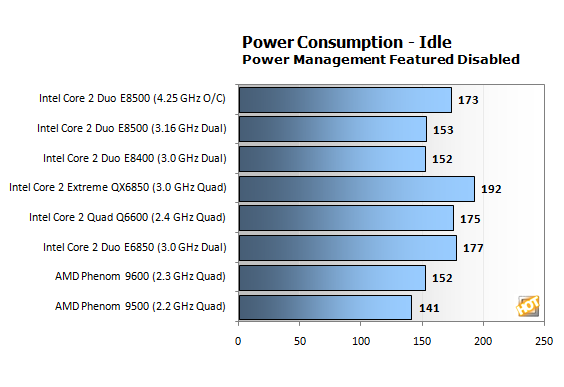Intel Core 2 Duo E8500 Wolfdale CPU
Power Consumption, Cooling and Overclocking
Intel ships their new Core 2 Duo E8x00 lineup of processors with an incredibly small aluminum alloy cooling unit, which tells volumes about the power consumption and heat production of the chip. While the new cooling system follows the same basic design as prior generation Core 2 retail cooling systems, Intel has stripped away the copper core and cut the surface area by roughly one half. The new cooling system is all aluminum alloy and is about half the height, but the chip still runs at very low temperatures (under 100F in most cases) and the fan never needed to spin up to high levels.
The chip supports C1E/Speedstep as well, which allows the chip to clock itself down to 2.0 GHz (6x multiplier) when processing levels are low. When processing loads kick up, the chip runs at 3.16 GHz (9.5x multiplier). Some new motherboards don’t support the .5x multipliers by default, which is the cause of most boards needing a BIOS update. If your motherboard doesn’t support half-step multipliers, the chip will boot up and run at 3.0 GHz (9.0x), which will allow you to get running and obtain a BIOS update.
For our overclocking testing, we threw on a much larger cooling unit with a copper core, heatpipes, and a much larger fan in order to see what this new chip was capable of. Combine the factors of a new architecture, new manufacturing process, and low power consumption/heat production by default, and we should have a solid overclocker. While the chip which Intel supplied to us is an ES (Engineering Sample), which means it does not have a multiplier lock like the final shipping chips will, we did not use this function in our overclocking tests. We left the multiplier at 9.5x to simulate what you will be able to obtain at home. Here’s what we were able to obtain on air cooling alone.
 Core 2 Duo E8500 - Stock Clocked @ 3.16 GHz |
 Core 2 Duo E8500 - Overclocked @ 4.3 GHz |
Yep. There it is. 4.3 GHz on air. Mighty impressive, considering Intel’s 65nm Conroe architecture struggled to make it past 4 GHz. These are some of the first 45nm chips out of the gate, and getting beyond 4.0 GHz is actually pretty easy with these chips. We’ve been stuck in the ~3.0 GHz range for so long, that seeing a system boot up with 4.0 GHz+ clock rates is quite exciting. This particular chip maxed out at 4301 MHz at its absolute peak, although it was not 100% stable throughout all of our tests. The highest stable overclock we were able to achieve, which could pass all of our benchmarks and stress tests was 4250 MHZ (4.25 GHz), which frankly, is still pretty impressive. In order to reach this clock speed, we had to bump up the core voltage up to 1.4V. We’ve included a whole set of benchmarks in the following pages of the E8500 running at this clock rate.
Power consumption is the other interesting variable which we were curious about. We tested using our standard methods of a hardware watt meter, with power loads tested with idle and full CPU load scenarios. Platforms remained identical, with the same components used across the board, with exception of the motherboard for Phenom comparison testing. Full CPU loads are tested while running the Cinebench R10 multi-core rendering test, which places 100% load on the CPU. C1E/Speedstep/power management was disabled for idle load scenarios, in order to eliminate this variable from the mix.


Our power consumption numbers show solid improvements for Intel’s new 45nm manufacturing process. At idle, the new 45nm Wolfdale 3.0 GHz dual-core consumes 152 watts, compared to 177 watts of a 65nm Conroe 3.0 GHz dual-core, a difference of 25 watts. That extends to 30 watts under full load. The E8500 chip consumes less power than most of the modern dual and quad-core processors in its price range. Even when it’s pushing 4.2 GHz+, the chip still consumes about the same amount of power as a stock-clocked Q6600 chip, which is surprisingly tolerable given the clock speeds we’re dealing with here.






